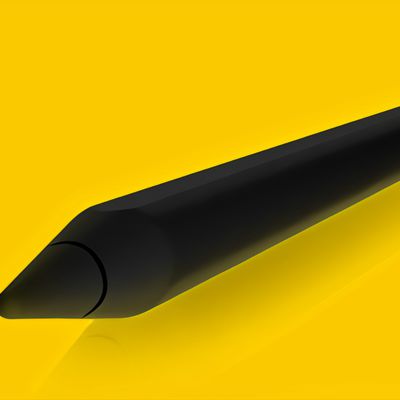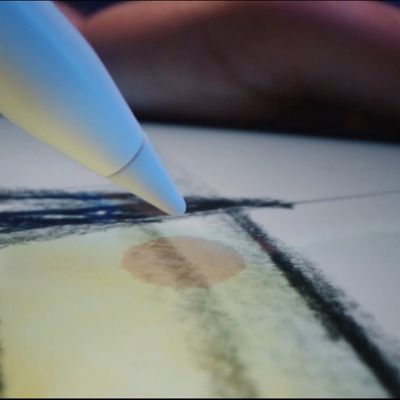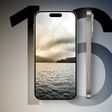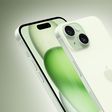Apple in 2015 unveiled the original Apple Pencil, its first stylus designed to work with the first-generation iPad Pro. Former Apple CEO Steve Jobs was famously against styluses, but the Apple Pencil has proven to be a useful tool for note taking, sketching, and more with the tablet form factor.
The Apple Pencil has stuck around since 2015, and as of today, all of Apple's iPads work with one of the three Apple Pencil models that Apple sells. In the guide below, we cover everything you need to know about the Apple Pencil.
What is the Apple Pencil?
The Apple Pencil is an Apple-designed stylus that works with Apple's iPads. It's called the Apple Pencil because of its resemblance to a traditional pencil, albeit with a definitively Apple-esque design.
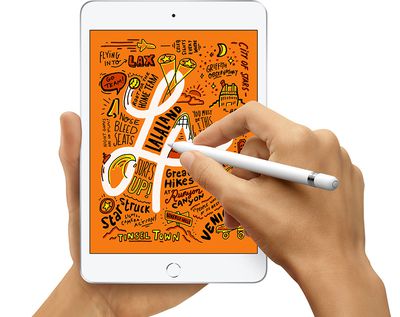
There's a small plastic tip (which can be replaced) that contacts the iPad's display, a pencil-like body to hold onto, and a charging mechanism. In the original Apple Pencil, there's a Lightning connector, but the second-generation model charges inductively through the iPad Pro while the cheapest 2023 model includes a built-in USB-C port.
The Apple Pencil is used in lieu of a finger for precision tasks like writing and sketching, and it can also be used for navigating through the operating system. It's excellent for drawing, art creation, note taking, and similar tasks because it's precise, has palm rejection, and offers tilt sensitivity and (on some models) pressure sensitivity.
In a nutshell, the Apple Pencil is meant to work like a traditional pencil, but instead of writing on paper, you write on the iPad's display. You can put your hand right on the iPad while you write, which, for a long time, was functionality other styluses were not able to accurately replicate.
What are the differences between Apple Pencil 1, Apple Pencil 2, and Apple Pencil USB-C?
There are three versions of the Apple Pencil. The first version was released in 2015, the second version was released in 2018, and the third version was released in 2023. The first- and second-generation Apple Pencil models have much of the same functionality, but the latest USB-C Apple Pencil has a lower price point and lacks some of the functionality available in the more expensive models.

The USB-C Apple Pencil has a design similar to the second-generation Apple Pencil, but it does not support pressure sensitivity or magnetic charging when attached to an iPad. We have a chart below that outlines the differences between the Apple Pencil models, and we also have a dedicated buyer's guide with more information about which you should choose for your iPad.
| Apple Pencil (first-generation, 2015) | Apple Pencil (second-generation, 2018) | Apple Pencil (USB-C, 2023) |
|---|---|---|
| Glossy finish | Matte finish | Matte finish |
| Weighted to prevent rolling | Flat edge to prevent rolling and snap to the side of an iPad | Flat edge to prevent rolling and snap to the side of an iPad |
| Attaches magnetically for storage, pairing, and charging | Attaches magnetically for storage | |
| Removable cap | Non-removable sliding cap | |
| Lightning connector | USB-C port | |
| Pair and charge via Lightning port or USB-C cable and USB-C to Apple Pencil Adapter | Pair and charge wirelessly | Pair and charge via USB-C cable |
| Pressure sensitivity | Pressure sensitivity | |
| Supports Apple Pencil hover on M2 iPad Pro models | Supports Apple Pencil hover on M2 iPad Pro models | |
| Double-tap to change tools | ||
| Free engraving option | ||
| $99 | $129 | $79 |
The second-generation Apple Pencil and USB-C Apple Pencil are sleeker, smaller, and more compact than the original Apple Pencil because they have no Lightning connector at the end. The second-generation Apple Pencil designed to charge inductively through the iPad Pro so you stick it on the right side of the iPad in the flat area to initiate charging, with the Apple Pencil held onto the device using magnets. The USB-C Apple Pencil can also magnetically adhere to an iPad, but it is not able to charge this way.

With the original Apple Pencil, there's a Lightning connector that lets it plug into the Lightning port of an iPad for charging purposes, which is inconvenient because of the size of the Apple Pencil. Apple also includes an adapter with the Apple Pencil 1 so you can charge it with any Lightning cable. The USB-C Apple Pencil has a built-in USB-C port that facilitates charging with a USB-C cable.
Apple Pencil 2 and the USB-C Apple Pencil feature a more pencil-like design with a flat side and a sanded design that improves the texture. The Apple Pencil 1 is smooth and round. Apple Pencil 2 also supports touch gestures for swapping between tools, something not possible with the original Apple Pencil or the USB-C Apple Pencil.
What devices are compatible with Apple Pencil?
The original Apple Pencil, manufactured from 2015 on with the round body design and Lightning connector, is compatible with the following devices:
- iPad mini (5th generation)
- iPad (6th generation and later)
- iPad Air (3rd generation)
- iPad Pro 12.9-inch (1st and 2nd generation)
- iPad Pro 10.5-inch
- iPad Pro 9.7-inch
The second-generation Apple Pencil with a smaller footprint and inductive charging capabilities is compatible with the following devices:
- iPad mini (6th generation)
- iPad Air (4th generation and later)
- iPad Pro 12.9-inch (3rd generation and later)
- iPad Pro 11-inch (1st generation and later)
The USB-C Apple Pencil is compatible with all iPads that have a USB-C port as it pairs to an iPad using a USB-C cable.
The original Apple Pencil cannot be used with models that are designed for the second-generation Apple Pencil, which includes the iPad mini 6 and the latest iPad Pro and iPad Air devices, and the Apple Pencil 2 does not work with older iPads nor entry-level devices like the standard iPad. The USB-C iPad works with newer models that have a USB-C port, including the 10th-generation low-cost iPad.
What are the Apple Pencil's features?
The Apple Pencil has a rich feature set, allowing it to be used for any precision task, or as a replacement for a finger when navigating through iOS.

The need-to-know features are below:
- Palm Rejection - When the Apple Pencil is connected to the iPad, it only recognizes the Apple Pencil tip and not your hand or your finger, allowing you to write or sketch comfortably.
- Pressure Sensitivity - Depending on how much pressure is placed on the iPad while writing or drawing, a line can be thicker or thinner. Apple doesn't provide a specific pressure sensitivity level for the Apple Pencil. This is limited to the first- and second-generation Apple Pencil models.
- Tilt Sensitivity - Apple Pencil is designed to work like a regular pencil, so if you hold it at an angle and press the side of the tip alongside the iPad for something like shading, it works. The Apple Pencil knows its general orientation and how it's being tilted.
- Pencil-Like Weighting - Apple designed the Apple Pencil to have a pencil-like feel in the hand, and it is weighted to feel like a real writing instrument.
- Low Latency - Apple Pencil has super low latency, which means that when you write on the iPad, there's no delay between the movement of the pencil and what appears on the display. Apple Pencil latency is as low as 9ms on iPads with 120Hz displays (the iPad Pro models from 2017 and later).
- Precision - Apple Pencil is precise, so it is accurate down to the pixel. That means there's no offsetting between where the pencil is located and what's shown on the screen.
- Simple Pairing - There's no need to fuss with Bluetooth with Apple Pencil. It connects automatically. Just plug in the first version, attach the second version to the iPad Pro via a Lightning port, or plug in the USB-C model with a USB-C cable.
- Touch Gestures (V2 only) - The second-generation version of the Apple Pencil supports touch gestures. With a double tap, the Apple Pencil 2 can swap between tools in apps, useful because it allows for quick switching between a pen tool and eraser tool, as an example.
- Inductive Charging (V2 only) - Apple Pencil 2 charges through the iPad Pro. Apple Pencil 1 does not have this feature and charges through a Lightning connector, while the USB-C Apple Pencil charges with a USB-C cable.
Where can Apple Pencil be used?
Apple Pencil can be used as a finger replacement to do things like open apps, scroll, and more, but support for Apple Pencil is also built into iPadOS. There are several unique Apple Pencil features worth being aware of for those thinking about an Apple Pencil purchase.

- Screenshots - If you take a screenshot on your iPad and then tap it when a preview appears in the corner, you can draw and write on it using the Apple Pencil through a feature called Markup.
- Markup - Markup is the Apple feature that lets you write on screenshots, but it also works across the operating system in various apps. In Mail, you can edit photos or PDFs (it's great for signing documents), in Messages, you can draw on photos, in the Photos app, you can add captions and drawings to images, and in Books, you can edit PDFs.
Apple Pencil also works with tons of third-party apps for note taking, drawing, sketching, and more. You can find these apps by searching for Apple Pencil in the App Store on the iPad, but below we've listed some standouts.
- Procreate ($9.99) - Ideal for sketching, drawing, and art creation. Simple enough for beginners, but powerful enough for professionals.
- Notability ($8.99) - Notability is a note taking app that's been around for a long time. It has all kinds of features for writing, sketching, annotating PDFs, and more, plus there are plenty of paper styles and it can scan documents, record audio clips, and more.
- Pixelmator ($4.99) - If you like to edit photos on your iPad, Pixelmator is worth checking out. It supports Apple Pencil, and the Apple Pencil is a great tool for precision edits.
- Pigment (Free with in-app purchases) - If you like to color and find it relaxing, there are tons of coloring apps for the Apple Pencil like Pigment.
- Adobe Fresco - Adobe Fresco is a drawing, painting, and sketching app from Adobe that also takes advantage of the Apple Pencil. It offers tons of Photoshop brushes, including live brushes and vector brushes, plus it has powerful tools for making selections, masking, adding layers, and more. It's free, but premium features cost $9.99 to unlock.
- Linea Sketch ($4.99) - If you like to jot down ideas and make quick drawings, Linea Sketch is easy to learn, easy to use, and has a useful range of tools for you to take advantage of.
How is the Apple Pencil different from other styluses?
Prior to when the Apple Pencil came out, styluses either had a fine hard tip and were battery powered to activate the capacitive display of the iPad, or had a wide, rubber finger-shaped tip that was not accurate.

Palm rejection was all done via software by individual app creators and it didn't work reliably, plus connections were all done via Bluetooth rather than the automatic process that the Apple Pencil uses.
Many styluses on the market that are not the Apple Pencil still have these kinds of tips that are nowhere near as accurate as the Apple Pencil and can't offer the same simple charging and palm rejection features, but there are now some more affordable Apple Pencil alternatives that have Apple Pencil-like functionality.
Is the Apple Pencil worth the money?
For anyone who wants to take advantage of the iPad for drawing, sketching, note taking, or other similar activities, the Apple Pencil is absolutely worth the money, but for those who don't need all of the advanced features, there are some similar styluses on the market like the much more affordable Logitech Crayon. The USB-C Apple Pencil is Apple's most affordable option at $79, with the original Apple Pencil priced at $99 and the Apple Pencil 2 priced at $129.

Does Apple Pencil work with iPhone?
The Apple Pencil, Apple Pencil 2, and USB-C Apple Pencil are only compatible with iPads and will not work with the iPhone. The Apple Pencil requires a display built for it, which iPhones do not have.
Will Apple make an Apple Pencil for iPhone?
There have been rumors here and there suggesting Apple could develop a version of the Apple Pencil for the iPhone, but no such product has ever materialized and rumors about an Apple Pencil for the iPhone have never been consistent.
What's next for the Apple Pencil?
Rumors have suggested Apple is working on a third-generation Apple Pencil, and details can be found in our Apple Pencil 3 guide. With the 2023 launch of the USB-C Apple Pencil, however, it's unclear when we might see another updated model.
Guide Feedback
Have questions about the Apple Pencil, know of a feature we left out, or want to offer feedback on this guide? Send us an email here.













